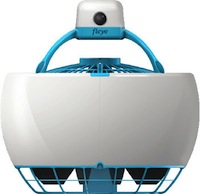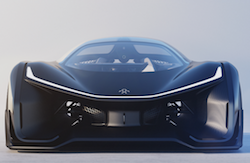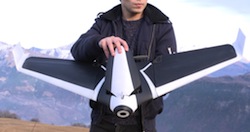 At last week’s CES show in Las Vegas, some of the most intriguing new gadgets were flying about within mesh fabric cages, crawling around robot pens, or ready to roll off their pedestals to cruise the Strip. And a growing number of these frenzied fiends run Linux.
At last week’s CES show in Las Vegas, some of the most intriguing new gadgets were flying about within mesh fabric cages, crawling around robot pens, or ready to roll off their pedestals to cruise the Strip. And a growing number of these frenzied fiends run Linux.
The most prominent mobile devices at CES were not boring old mobile phones or tablets, but unmanned autonomous vehicles, better known as drones. New Linux-based UAVs include Parrot’s fixed wing Disco, Zerotech’s Snapdragon Flight based Ying, as well as new autopilots that turn a Raspberry Pi board into a flight computer (see below). These newcomers were joined by other recently announced Linux drones, such as the indoor-ready Fleye and Parrot’s BeBop 2.
Terrestrial robots, too, were in abundance, ranging from kids’ educational robots such as Lego Education’s Mini Molo to Xiaomi’s Ninebot Segway, which converts from a stand-up transporter to a follow-me camera robot.
On the ground, robots competed with increasingly robotic automobiles, including assisted driving ADAS and fully autonomous models. There were also new electric cars ranging from the relatively affordable ($37,000) Chevy Bolt to Faraday Future’s 1,000-horsepower FFZERO1 prototype, which is the spitting image of the Batmobile.
Some of the more interesting Linux-related announcements were development platforms. These included the Linux Foundation’s Automotive Grade Linux Unified Code Base distribution, which features GENIVI components. The AGL Group also signed up new members including Ford, Subaru, Mazda, and Mitsubishi Motors.
Nvidia showed off a next-generation Drive PX 2 platform for self-driving cars claimed to offer 8 teraflops of processing power with 24 trillion deep learning operations a second, or 10 times the performance of the original Drive PX. The new board, which Volvo will trial in 2017, will run on dual “next-gen Tegra processors and discrete GPUs based on our Pascal architecture,” says Nvidia. Meanwhile, Qualcomm announced a Linux-ready, automotive version of its latest Snapdragon 820 SoC aimed at ADAS cars.
As usual at CES, the OS used within devices was often difficult if not impossible to track down. This was especially true of consumer electronics devices ranging from smart TVs to AV streaming players to home automation gizmos. Most likely, the majority of these devices run Linux. This is especially true of smart TVs, but less so among smart devices that connect to typically Linux-based home automation hubs.
In years past, you could count on vendors proudly proclaiming an Android OS, but this year it seemed there were either fewer major new Android devices, or vendors were less vocal about it. The Internet of Things (IoT) revolution is being driven by less resource-consuming versions of Linux. By next year, Google’s lightweight Android-based Brillo may end up having its CES week in the sun, but this year it was still mostly undercover, although it popped up in Marvell’s Brillo- and Linux-ready Andromeda Box Connect development SBC. The IoT gateway oriented board followed a recently announced, and more powerful, 64-bit Andromeda Box Connect.
In wearables, where Linux has yet to achieve much traction except for Android, most of the action was in Bluetooth-ready fitness swatches and health monitoring devices that typically lack a formal OS. There were a few new Android Wear devices, however, such as the sports-focused Casio WSD-F10. Samsung showed off some premium, Tizen Linux-based Gear S2 Classic watches and announced that iPhone compatibility for its Gear watches would arrive soon.

Samsung Tizens It All Together
Arguably, the major IoT story of the show concerned another Samsung Tizen product line. Samsung announced that all of its Tizen-based, 2016 Smart TVs will be able to act as SmartThings home automation hubs, letting you keep tabs on your household while watching TV. Samsung also announced a Tizen-based Family Hub refrigerator that can be fitted with SmartThings hub functionality.
In addition, Samsung updated its Tizen TV UI, and launched a Tizen-based universal Samsung Smart Control with automatic source recognition. The remote is claimed to immediately recognize set-top boxes, OTT boxes, Blu-ray players, game consoles, and other connected devices.
As The Verge noted in a story called “We should probably quit sneering at Tizen,” Samsung finally has a coherent strategy and some great products surrounding the increasingly mature, open source Tizen. The fast-growing Tizen ecosystem should help us forget about Samsung’s confused and delayed rollout of Tizen phones.
Drones Take On New Shapes and Dimensions
The most anticipated drone announcement of CES was not to be — GoPro’s upcoming Karma quadcopter was still all talk — but there were a few other major drone announcements, not to mention scores of smaller launches and prototypes.
Not long after Parrot shipped its BeBop 2 quadrotor, the company expanded its Linux and Dronecode-compatible UAV platform to a new fixed-wing drone called the Disco. The airplane-like Disco can fly for up to a claimed 45 minutes — 20 minutes longer than the long-duration BeBop 2 — at up to a 50 mph. It has the same auto-stabilized, 14-megapixel camera as the BeBop 2, and offers some new autopilot modes.
Also at CES, Shenzhen-based Zerotech announced its first Linux-based model with an upcoming Ying quadcopter that runs on Qualcomm’s Dronecode-compatible, Ubuntu-driven Snapdragon Flight reference platform. The Ying’s camera will stream video to Tencent’s social community platforms Wexin and QQ.
Last September, Qualcomm said that Yuneec would ship the first Snapdragon Flight based drone in 2016, but Zerotech beat it to the punch. Yuneec instead unveiled an impressive, but apparently still proprietary, Typhoon H hexacopter that offers an optional Intel RealSense 3D depth camera for superior obstacle avoidance.
The Typhoon H was one of several recent RealSense design wins for Intel announced at CES, including a second-generation, Linux-based Daqri Smart Helmet, which provides augmented reality assistance to industrial workers. Last year at CES 2015, Intel showed off RealSense integrated with a Linux-based drone from German drone vendor Ascending Technologies (AscTec). This year at CES, Intel announced it is acquiring the company. AscTec makes a range of professional (AscTec Falcon 8) and research (AscTec Firefly) UAVs that run Ubuntu on Intel CPUs.
Industry-leading drone vendor DJI released a 4K camera version of its flagship Phantom 3 quadcopter, as well as a more open mobile development kit. DJI also launched its third annual Developer Challenge, which for the first time is built around Linux. The company has joined with Ford on a challenge in which developers use DJI’s new Ubuntu- and Tegra K1-based Manifold autopilot designed for its high-end Matrice 100 drone to build apps for search and rescue missions for the UN. Winning apps must enable the drone to take off from a moving Ford pickup and relay information on disaster zones back to the Ford’s AppLink connectivity technology before returning to land on the moving truck.
Smaller drone launches included a Kickstarter campaign that finished up on January 9 for a $150 PowerUp FPV. This paper airplane drone offers an open source Linux SDK and can tap Google Cardboard as a viewer.
Also at CES, Erle Robotics, which has previously launched open source Linux UAVs like the Erle-Copter, introduced a Dronecode-compatible PXFmini drone autopilot board designed for the Raspberry Pi. This 15-gram, $74 and up shield supports any Pi, but is optimized for the equally compact, lightweight Raspberry Pi Zero. The PXFmini competes directly with Emlid’s second-generation Navio2 autopilot shield for the Pi. Navio2 ships in a few weeks, adding HAT compatibility, among other improvements.
Finally, the number one show-stopping drone of CES 2016 was not so much a drone as an autonomous helicopter. EHang, known for its Ghost Drone UAVs, showed off the EHang 184 prototype that can transport a 220-pound person for 23 minutes. We don’t know if it runs Linux, or even if we’d risk riding in one, but it looks like it beats sitting in a traffic jam.


